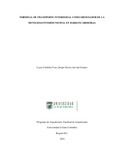Mostrar el registro sencillo del Documento
Terminal de transporte intermodal como ordenador de la movilidad intermunicipal en Barrancabermeja
| dc.contributor.advisor | Roa Castillo, Edgar Eduardo | |
| dc.contributor.author | Arevalo Gomez, Sergio Stiven | |
| dc.contributor.author | Córdoba Toro, Lucas | |
| dc.date.accessioned | 2021-12-15T16:34:23Z | |
| dc.date.available | 2021-12-15T16:34:23Z | |
| dc.date.issued | 2021 | |
| dc.identifier.uri | http://hdl.handle.net/11396/7085 | |
| dc.description | Barrancabermeja es una ciudad situada al occidente del departamento de Santander a las orillas del Rio Magdalena. Desde el 12 de octubre de 1536 este territorio ha sido muy importante por la explotación del petróleo, por lo que cuenta con la sede de la refinería más grande del país. Debido al desarrollo urbano y demográfico, influenciado por la industria petrolera, las conexiones de la ciudad con el resto del país han aumentado, y a su vez el flujo de personas que llegan a esta. La ciudad de Barrancabermeja tiene altas oportunidades de desarrollo urbano gracias a su carácter turístico, y petrolero. Sin embargo, respecto a su infraestructura de movilidad, se identifica la ausencia de un equipamiento de transporte terrestre consolidado, que pueda unificar los medios de transporte en la ciudad y mejore el sistema de transporte. El presente trabajo pretende analizar la ciudad, e investigar su comportamiento para proponer una solución arquitectónica de nivel metropolitano, que logre articular la ciudad con el resto de los municipios del país, a través del diseño del terminal intermodal que logre abastecer las necesidades necesarias de la población y la ciudad. | spa |
| dc.description.abstract | Barrancabermeja is a city located to the west of the department of Santander on the banks of the Magdalena River. Since October 12, 1536, this territory has been very important for the exploitation of oil, which is why it has the headquarters of the largest refinery in the country. Due to urban and demographic development, influenced by the oil industry, the city's connections with the rest of the country have increased, and in turn the flow of people arriving there. The city of Barrancabermeja has high opportunities for urban development thanks to its tourist and oil nature. However, regarding its mobility infrastructure, the absence of a consolidated land transport equipment is identified, which can unify the means of transport in the city and improve the transport system. The present work aims to analyze the city, and investigate its behavior to propose an architectural solution at a metropolitan level, which manages to articulate the city with the rest of the municipalities of the country, through the design of the intermodal terminal that manages to supply the necessary needs of the population and city. | spa |
| dc.language.iso | spa | |
| dc.publisher | Universidad La Gran Colombia | spa |
| dc.rights | Attribution-NonCommercial-NoDerivatives 4.0 International | * |
| dc.rights.uri | http://creativecommons.org/licenses/by-nc-nd/4.0/ | * |
| dc.subject | Ciudad, desarrollo, infraestructura de movilidad, terminal, intermodal. | spa |
| dc.subject | Ciudad | spa |
| dc.subject | Desarrollo | spa |
| dc.subject | Infraestructura de movilidad | spa |
| dc.subject | Terminal | spa |
| dc.subject | Intermodal | spa |
| dc.title | Terminal de transporte intermodal como ordenador de la movilidad intermunicipal en Barrancabermeja | spa |
| dc.subject.lemb | Instalaciones para estaciones de transporte | spa |
| dc.subject.lemb | Desarrollo urbano sostenible | spa |
| dc.subject.lemb | Planificación regional | spa |
| dc.publisher.department | Arquitectura | spa |
| dc.publisher.program | Arquitectura | spa |
| dc.subject.keyword | City | spa |
| dc.subject.keyword | Development | spa |
| dc.subject.keyword | Mobility infrastructure | spa |
| dc.subject.keyword | Terminal | spa |
| dc.subject.keyword | Intermodal | spa |
| dc.publisher.branch | Bogotá | spa |
| dc.creator.degree | Arquitecto(a) | spa |
Ficheros en el Documento
Este Documento aparece en la(s) siguiente(s) colección(ones)
-
Arquitectura [1096]






